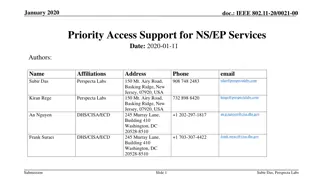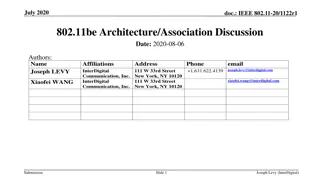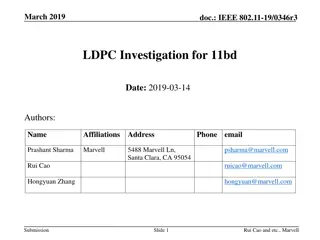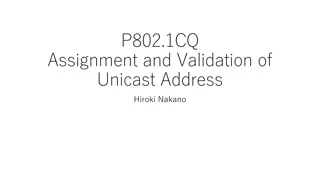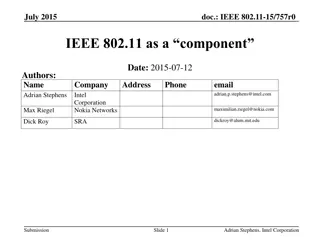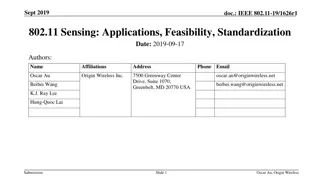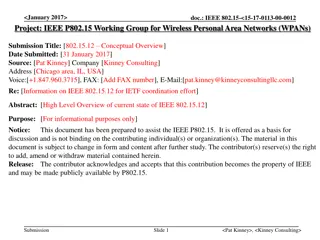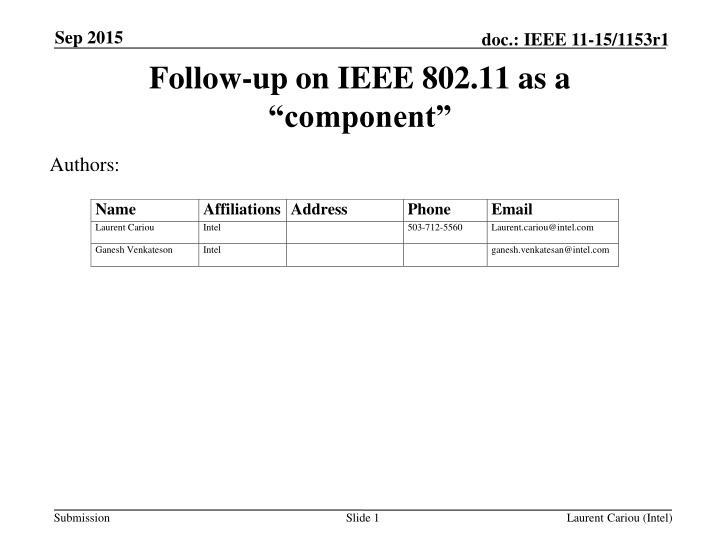
Enhancing 802.11 Technology for Future Wireless Networks
Explore the progression of IEEE 802.11 technology as a key component in wireless networks beyond 2020. Discover insights on 5G evolution, network objectives, and the impact on vendors, end-users, and service providers. Stay informed for the next generation of wireless connectivity.
Download Presentation

Please find below an Image/Link to download the presentation.
The content on the website is provided AS IS for your information and personal use only. It may not be sold, licensed, or shared on other websites without obtaining consent from the author. If you encounter any issues during the download, it is possible that the publisher has removed the file from their server.
You are allowed to download the files provided on this website for personal or commercial use, subject to the condition that they are used lawfully. All files are the property of their respective owners.
The content on the website is provided AS IS for your information and personal use only. It may not be sold, licensed, or shared on other websites without obtaining consent from the author.
E N D
Presentation Transcript
Sep 2015 doc.: IEEE 11-15/1153r1 Follow-up on IEEE 802.11 as a component Authors: Name Laurent Cariou Affiliations Address Intel Phone 503-712-5560 Email Laurent.cariou@intel.com Ganesh Venkateson Intel ganesh.venkatesan@intel.com Submission Slide 1 Laurent Cariou (Intel)
Sep 2015 doc.: IEEE 11-15/1153r1 Motivation and purpose At the July meeting a tutorial titled IEEE 802.11 as a component was presented. A lot of feedback was received during the presentation and in offline conversations following the presentation. Straw polls at the end of the tutorial indicated interest and support. There were also requests for more details. This contribution Provides the first steps in our work to better define the need and scope for this activity, attempts to answer some questions, Highlights how this activity could benefit vendors of 802.11 implementations, end-users and service providers, in the incoming years (2020 and beyond) Submission Slide 2 Laurent Cariou (Intel)
Sep 2015 doc.: IEEE 11-15/1153r1 802.11 as a component General objective So far, 802.11 has done a great job in offering the right service to the right customers, hence becoming ubiquitous Thanks to this, in times where densification is an important driver of network deployments, 802.11 is more than ever the solid incumbent: Home, enterprise and most venues already provide access to the inter/intranet over 802.11 from any device and satisfy the end-user needs In that sense, 802.11 is definitely an integral part of current wireless networks. The objective of this activity is to ensure that 802.11 technology will remain and continue to grow as the wireless technology of choice in the incoming years. Submission Slide 3 Laurent Cariou (Intel)
Sep 2015 doc.: IEEE 11-15/1153r1 5G terminology to describe the evolution of wireless networks in the incoming years 5G carries different meanings in different context It is linked to cellular/mobile networks evolution (follow-up of 4G), and cellular operators are the most vocal in trying to define its requirements (NGMN, ) But it can be perceived to refer to a wider concept, a general evolution of wireless networks, inclusive of all actors Even if 5G documentations are still evolving, it is a good source of information for evolution of wireless networks, services, and requirements for 2020 and beyond. In this presentation, we focus more on cellular operator perspective, having in mind that similar analysis should be initiated for all other actors, especially the ones relying strongly on 802.11 technology Submission Slide 4 Laurent Cariou (Intel)
doc.: IEEE 11-15/1153r1 Cellular 5G Objectives High-level objectives compared to 4G: Higher throughput (10X), lower latency, support higher user density (100X), available everywhere Lower cost, better energy efficiency Able to support a wider range of services Submission 5 Laurent Cariou (Intel)
Sep 2015 doc.: IEEE 11-15/1153r1 A big part of Cellular 5G objectives will be met with densification Illustration of the different categories of improvements that will help reach the objectives Submission Slide 6 Laurent Cariou (Intel)
Sep 2015 doc.: IEEE 11-15/1153r1 Wi-Fi would easily achieve cellular 5G densification target Wi-Fi AP to Macro cell ratios is already roughly 50:1, approaching 5G required ratio 450,000 400,000 Worldwide 350,000 300,000 250,000 (Thousands) 200,000 150,000 100,000 50,000 000 2012 2013 2014 2015 2016 2017 2018 2019 2020 ABI: Installed macrocells and small cells ABI: WiFi APs deployed worldwide Submission Slide 7 Laurent Cariou (Intel)
Sep 2015 doc.: IEEE 11-15/1153r1 Wi-Fi would easily achieve cellular 5G densification target Reaching this level of densification is challenging for operators: cost, installation (especially indoors - negotiation with venue owners), management, Some key facilitators: Use of unlicensed spectrum facilitates this at the cost of spectrum control Use of neutral-host small cells deployed locally (Small cell as a service (SCaaS)) facilitates this at the cost of network ownership for operators WLAN as a service (WaaS) combines these facilitators and is therefore a very competitive solution to help operators reach this level of densification It consists of a venue-driven deployment, managed by a neutral host, which supports multiple operators, each using this WiFi network as a BlackBox Benefits: Fast deployment of services, low cost for all actors, beneficial for venue-owner, and for any types of operators, Submission Slide 8 Laurent Cariou (Intel)
Sep 2015 doc.: IEEE 11-15/1153r1 assuming it can easily be accessed and reaches the level of flexibility needed for future services WaaS solutions exist today As a blackBox without much interface Do we need to make modifications to 802.11 to consolidate this model for 2020 and beyond? What will be the right balance between what stays in the BlackBox and what is exposed/open? What is needed to enable added-value for operators? In order to meet the requirements: Simple, seamless, secure access With features and flexibility to support new services With the right level of integration with each operator s network Submission Slide 9 Laurent Cariou (Intel)
Sep 2015 doc.: IEEE 11-15/1153r1 2020 WaaS: evolution of 802.11 technology? Simple, Seamless, Secure access 802.11u/WFA s Passpoint facilitates simple, seamless and secure access 802.11ai further improves some aspects of it Can/should we do better? Suppress redundancy for authentication, security between different radio access technologies Faster/simpler Should we further improve 802.11 network selection Clearer metrics, interface to access them Submission Slide 10 Laurent Cariou (Intel)
Sep 2015 doc.: IEEE 11-15/1153r1 2020 WaaS: evolution of 802.11 technology? Support new services and new network functionalities WaaS should be flexible to enable fast deployment of new and diverse services 5G has the ambition to enable services that would require an adaptation or an interface with lower layers Tactile internet (better QoS mapping), Massive IoT, location-based services (need for context information) If we want WaaS to be the neutral-host home of 5G networks in venues, we need to evaluate the implications on how it should interface with other networks and with service platforms. What level of adaptation is needed in lower layers to flexibly enable important services in the future? Submission Slide 11 Laurent Cariou (Intel)
Sep 2015 doc.: IEEE 11-15/1153r1 2020 WaaS: evolution of 802.11 technology? Integration with cellular networks (1/2) Non-integrated neutral-host 802.11 networks seem sufficient as of today for most services Currently, all main traffic/services can go through 802.11 network, even voice The added value of a deeper integration is limited for the operators In the future? Better interfaces of WaaS with operator networks can provide added value to operators and users, for example: User experience: Enable multiple operators to manage and negotiate QoS prioritization on these neutral WaaS networks, Aggregated throughput: Enable multiple operators to deploy LWA (LTE-Wi-Fi Aggregation) on neutral WaaS networks, Management/control: provide some level of control to multiple operators Submission Slide 12 Laurent Cariou (Intel)
Sep 2015 doc.: IEEE 11-15/1153r1 2020 WaaS: evolution of 802.11 technology? Integration with cellular networks (2/2) An example: Throughput aggregation LWA (LTE-Wi-Fi aggregation) is under definition in 3GPP (RP-151114) For WiFi APs collocated or non-collocated with LTE small cells In the latter case, it defines a control plane interface Xw between eNB and WLAN Termination (WT) integrated into AP, AC By defining the 802.11 side of this interface, we could enable operators to quickly deploy such aggregation solution, even on neutral-host Wi-Fi networks (WaaS) This would improve the services provided by WaaS What would be needed: Monitoring for flow control (load balancing between LTE and WiFi) Tools for discovery and metrics for WiFi network selection Non-duplicated association/security (security bootstrapping mechanism: PSK-like key is generated by the eNB and configured to UE and WT) Submission Slide 13 Laurent Cariou (Intel)
Sep 2015 doc.: IEEE 11-15/1153r1 Conclusion This presentation has the objective to initiate the work to better define the need and scope for this activity: 802.11 as a component of 5G Starting from a very high-level analysis targeting mobile operator Studies are needed to: better understand 5G evolution and requirements, including the vision from other actors (OTT players, device vendors, cable operators ) Clarify the use cases and needs to see if changes are needed in 802.11, and what changes Submission Slide 14 Laurent Cariou (Intel)






